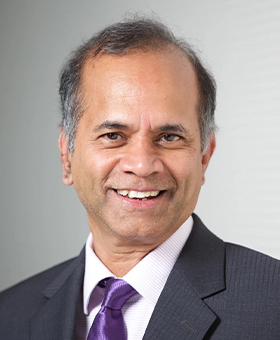
Rama Chellappa
Rama Chellappa, a Bloomberg Distinguished Professor in electrical and computer engineering and biomedical engineering and chief scientist at the Johns Hopkins Institute for Assured Autonomy, is a pioneer in the area of computer vision, pattern recognition and artificial intelligence. His work in these areas have had a profound impact on areas including biometrics, smart cars, event detection, forensics, and 2D and 3D modeling of faces, objects, and terrain. His work in markerless motion capture and medical imaging has applications in health care and medicine.
He joined Johns Hopkins after 29 years at the University of Maryland (UMD) where he served as chair of the Department of Electrical and Computer Engineering and director of the Center for Automation Research. He has received numerous awards for teaching, research, service and mentoring, while at University of Maryland. He is a member of Johns Hopkins’ Center for Imaging Science, the Center for Language and Speech Processing, the Malone Institute for Engineering in Healthcare, and the Mathematical Institute for Data Science.
Chellappa’s research has shaped the field of facial recognition technology—developing detailed face models based on shape, appearance, texture, and bone and muscle structure. Under a recent program called Janus, he and his team have developed a high-accuracy face recognition system that serves critical needs for federal and commercial sectors. The team has also worked on modeling facial expressions, with potential for a variety of medical applications.
He also is known as an expert in machine learning, a branch of artificial intelligence that instructs computer systems to perform tasks based on patterns and inferences. He is working on understanding and mitigating bias in machine learning algorithms as well as designing AI systems that are robust to adversarial attacks and domain shifts.
Chellappa has also worked on gait analysis, which can apply to an enormous range of uses—everything from diagnosing movement-related disorders to human identification at a distance. He will continue the work on human identification using gait in a new IARPA effort known as BRIAR. He is also involved in a new five-year effort on Artificial Intelligence and Technology Collaboratory for Aging Research from the National Institute of Aging.
Chellappa is the 2020 recipient of the Jack S. Kilby Signal Processing Medal for his contributions to image and video processing, particularly face recognition. This is one of the top honors from the Institute of Electrical and Electronics Engineers (IEEE), where Chellappa is a life fellow and previously served as the editor-in-chief of IEEE Transactions on Pattern Analysis and Machine Intelligence. Among many other honors, Chellappa has also won technical achievement awards from the IEEE Computer Society and the IEEE Signal Processing Society; the latter also awarded him with its highest honor, the Society Award. He was recognized as a Distinguished Alumni by the ECE department at Purdue University and as a Distinguished Alumni by the Indian Institute of Science, Bengaluru, India. He is a Fellow of AAAI, AAAS, ACM, AIMBE, IAPR, IEEE, NAI and OSA.
He earned his doctorate in electrical engineering from Purdue university, studying under mentors including R.L. Kashyap, Keinosuke Fukunaga, and King Sun-Fu. (Some three decades later, Chellappa won the esteemed award named for Sun-Fu, from the International Association of Pattern Recognition.)
During his doctoral studies, he also conducted research at the University of Maryland (UMD) with Azriel Rosenfeld, one of the founding fathers of computer vision. Chellappa later joined UMD as a professor in 1991, after 10 years at the University of Southern California.

